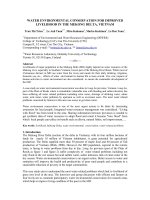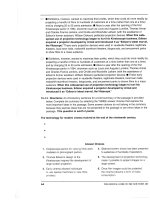Tài liệu The Official Rules for Winning Management in Any Field doc
Bạn đang xem bản rút gọn của tài liệu. Xem và tải ngay bản đầy đủ của tài liệu tại đây (906.01 KB, 266 trang )
The Official Rules for
Winning Management
in Any Field
by
Jeff Angus
Baseball
Management Contents
Acknowledgments v
Introducing Management by Baseball 1
1. The View from the Blimp 8
PART I: Getting to First Base—Mastering Management Mechanics 25
2. Out of the Box: Starting a New Management Mission 29
3. Executing the Fundamentals: Marshaling Time, Humans,
& Knowledge 49
4. Calling for the Hit-and-Run: Making Decisions 68
PART II: Stealing Second Base—the Players
Are
the Product 87
5. Scouting & Signing Your Players: Hiring 89
6. Charting Hits: Optimizing Player Performance 106
7. Drills: Juggling the Lineup 125
8. Down to the Minors: Reprimanding, Demoting, & Firing 143
PART III: Advancing to Third Base—Managing Yourself 161
9. There’s No “I” in “Team,” but There Are an “M” and an “E”:
Emotional Self-Awareness 163
10. Plate Adjustments: Intellectual Self-Awareness 184
PART IV: Crossing Home Plate—Managing Change 197
11. Lowering the Pitcher’s Mound: What Is Change? 199
12. When They Rewrite the Rule Book: Responding to Changes 209
13. The Man Who Invented Babe Ruth: Getting a Step Ahead
by Initiating Changes 223
Epilogue: But, but, but 235
Notes 239
Index 245
About the Author
Credits
Cover
Copyright
About the Publisher
Acknowledgments
A
bove all others and to more than all others combined, STEVE
MANES, whose vast, constant support, wisdom, and navigation of
the publishing world saved me slings and errors of outfielding fortune.
Steve Rees for unending moral and logistical support, connections with
knowledge, bulk printing, and for keeping that rhythm on percussion. For
this book’s editor, Herb Schaffner, who graciously put up with me and the
turbulence of too much material and too little time, and who came out to
the mound at the exact right times to remind me how to throw strikes.
But without the generous insight, research, and teaching of these oth-
ers, there would not be a book worth reading: Earl Weaver, Dick Williams,
Al Hrabosky
, Martín Dihigo, Ray Miller, Seans Gallagher, and Forman
and Lahman, Tom Ruane, Alan J. Kaufman, Don Malcolm, Mikes
Emeigh and Scioscia, Bill McCarthy, Darren Viola, Dick Cramer, Steve
Steinberg, Erik Hansen, Tom Peters, Biz Stone, Frank Patrick, Joe Ely,
Mike of MLB Center, Rico Carty, Michael Dineen, Rick Peterson, Dave
Perkins, Jen Grogono, Bob Buckman, Dr. Mike Kositch, Dr. Grant
Sterling, Dr. Logan Davis, Dr. David Weinberger, Susan Madrak, Rep.
H. John Heinz III, Terry Gilliam and Salman Rushdie, Anita Fore, Stuart
J
ohnston, Lisa Gray, Rich Levin, Clint Wilder, Raymond D. Watts, Buck-
minster Fuller, Ray Calamaro, Connie Marrero, Barry Mitzman, Bill
Veeck, The Twelve, Steve Gillmor, Martin Marshall, Doug Dineley, the
Dixie Peach, Mario Machado, and Bob “Death to Flying Things” Fergu-
son. To the editors who sharpened the content: Diane Bruch, Pam Beason,
B
ill Anscheutz, Maria A. S. Ward, D. S. Aronson, and Adam Goldberger.
And to my Management Hall of Famers (Underappreciated Wing):
Rachel K. E. Black, Gary Brose, Greg Smith, Scott Boutwell, Alexis Laris,
Mark “Mad-dog” Eppley, Chris Logan, and my evil antipodal twin, Paul
Heath.
%
Managing is getting paid for home runs someone else hits.
—Casey Stengel
M
anagement consultant by day, major–league-baseball writer by
night, I didn’t see the connection between my two jobs. Then came
the day I witnessed a remarkably self-destructive client insist on a foolish
decision—and in the evening watched the worst manager of post–World
War II baseball destroy his team’s slender chances for the season with a
boneheaded move hauntingly identical to my client’s.
I’d spent a too-long day trying to convince my consulting client that
he had lots of wasted talent wor
king for him. An experienced manager re-
cently hired to run a chronically low-performance work group, he had re-
organized the group to match his own ideal structure, then unilaterally
r
ebuilt job descriptions to correspond to his new structure. He delegated
too rarely. When he did delegate, he assigned tasks strictly on the basis of
employees’ job descriptions, not their individual skills. He completely ig-
nored the people as individuals, imagining they’d just step up to the plate
and deliv
er what the new structure required. He knew he could do it, so
they could, too. I tried to explain to him the fallacy limiting his group’s
success. My words just wouldn’t reach him.
That evening, I was working at my baseball-writing job, watching the
str
uggling Seattle Mariners, not paying as much attention to the game as
I should have. I kept sifting through my brain for some hook that would
make clear to my client why he needed to modify the way he operated
and then it happened.
2 Management by Baseball
Jeff Burroughs, a massively muscled, barely motile Mariner slugger,
was on first base. He took off, trying to steal. What happened next un-
folded like an auto accident you’re involved in—in slow motion so you
get to sav
or every ugly detail. Burroughs started lugging. Then, at the
speed of a tectonic plate, the lug went into the least graceful slide I’d seen
since Little League. Finally, to add injury to insult, he crashed into the in-
fielder tagging him out. He had to be scraped off the field like some igno-
minious roadkill—existential humor at its most unsightly. Burroughs
missed a chunk of the season, ther
eby weakening an already anemic of-
fense.
Was the slug-like Burroughs afflicted with a sudden dementia? Nope.
After the game, M
ariner manager Maury Wills explained that the signal
to steal had come from the skipper himself. Wills had once been the pre-
mier base stealer in the majors, a compact, efficient speed merchant with
an unerring ability to r
ead pitchers and their moves, an exceptional talent
that made him famous. Like most people, he came to believe that the tal-
ent most important to his car
eer was the talent most important for win-
ning. It’s a classic management blunder.
Moreover, any intelligent baseball observer would have understood
that this par
ticular steal was a low-yield idea. First, the 30-year-old Bur-
roughs had no history of success stealing bases. For every base you get
thr
own out stealing, you need roughly two successes just to break even.
Burroughs’s history with stealing was net deficit; for every base he stole, he
had been thrown out once, costing his team scoring chances.
Second, Burroughs was a key player with a good batting average, and
unlike almost ev
erybody else on the Mariners squad, he was also able to
deliver the single most valuable offensive event, the home run. Third, the
Mariners were playing their games in the Kingdome, a park that boosted
offense at the cost of bludgeoning pitchers. The games the M’s played
there were far more likely to be decided by a big offensive inning than by
squeezing out a run from a steal.
So by sending the steal sign, Wills had risked the health of one of his
Introducing Management by Baseball 3
least replaceable resources—a power hitter. He had done it in a park that
was the worst possible environment for a steal. And he had done it with a
player whose record shouted, “Stay on your base, Sparky!”
As all this was spinning through my head, I realized two critical
things.
I realized Wills’s decision flew in the face of something Dick Williams,
one of the two most successful modern baseball managers, had said to me.
W
illiams stressed that managers needed to make moves based on the con-
tents of their roster, always considering the abilities of each player in spe-
cific situations. I also realized my client was making the exact mistake
M
aury Wills was making. He was trying to make his “roster” succeed at a
game he himself had mastered, but one that they hadn’t.
That night in the press box, the epiphany hit me as hard as a Randy
J
ohnson inside fastball. I could apply my interest in the management,
strategy, tactics, business, and sociology of baseball to the practice of man-
agement in general. Once I opened myself to the thought, baseball lessons
star
ted appearing in my consulting practice all the time.
Baseball management, I realized, reflects more general management
principles, mor
e clearly and more broadly, than any of the academic
teachings we normally use in organizations. I started experimenting with
baseball models to coach managers in business, government, and non-
profits, especially those with no formal training in the profession—the
majority. Using lessons from the National Pastime turned out to be a
dynamic, effective method for accelerating my clients’ learning process.
The client I was working with the day Maury Wills imploded was a
casual baseball fan. H
e’d never heard of Steve Dalkowski, but two days
after Burroughs went on the disabled list, I saw the client again and told
him about the legendary pitcher, almost an apocryphal figure in minor-
league history. I thought the Dalkowski story would show him what he
needed to know about teaching, personal limitations, and maximizing his
employees’ contributions better than I could in three hours of business-
speak.
4 Management by Baseball
Steve Dalkowski was a fireballing lefty. Some minor leaguers, includ-
ing Ron Shelton (who went on to write films such as B
ull Durham and
Tin Cup), believed he was the hardest thrower in the history of the game.
Shelton said he blew pitches past Ted Williams in spring training, and
quoted Teddy Ballgame, who called Dalko the “fastest ever” and added, “I
never want to face him again.” Earl Weaver, the other top modern base-
ball manager, managed the pitcher at two minor-league levels. He stated
that D
alko had thrown wild pitches through two different steel-mesh
backstops, breaking one of them 60 feet behind the catcher. In his first
pro season, the southpaw struck out 10 of the first 12 batters he faced
without anyone touching the ball with a bat. He probably threw close to
100 mph.
But Dalkowski had limitations. He had only two pitches, a fastball
and a slider
. In the Orioles system, they liked guys who threw at least a
third pitch at a slower speed (usually a curve) to keep the hitter worried
about the fourth dimension, and Dalkowski couldn’t learn the off-speed
pitch. Plus, he usually had zero ability to control his pitches.
Shelton cites a no-hitter where Dalko struck out 21 and walked 18,
and the 1960 season at S
tockton, where in 170 innings he struck out
262 and walked the same number. Weaver wrote about a game where
Dalko threw 280 pitches (starters usually go about 110 now) and lost no
velocity on his fastball while striking out 16, walking 17, and winning
4–3. All three runs scored on bases-loaded wild pitches.
The O’s knew what a rare asset they had, but baseball teams, like most
large organizations, hav
e rules that are accepted as commandments. For
the O’s, the commandment read “All pitchers shalt have an off-speed
pitch.” Paul Richards, the mastermind behind three decades of Oriole
pitching dominance, kept trying to teach Dalko the pitch, and the
moundsman kept not learning it.
One season, still-minor-league manager Weaver got permission to
giv
e a Stanford-Binet (IQ) test to all the entry-level players in the system.
It turned out, Weaver wrote, that “the test indicated that Richards was
Introducing Management by Baseball 5
wasting his time. Dalkowski finished in the 1st percentile in his ability
to understand facts. Steve, it was sad to say, had the ability to do every-
thing but learn The mor
e you talked to Dalkowski, the more it con-
fused him.”
Halfway through the 1962 season, Weaver taught him one simple
idea: that if
he didn’t throw strikes, all the batters would walk, and he’d
lose. In the second half, Dalkowski threw 57 innings, gave up one earned
run (ERA = 0.16), and racked up 100 Ks with only 11 walks. Weaver fig-
ured if the man could do that with only two pitches, let him ride it until
he failed. B
ut higher-ups insisted on the curveball and kept making him
work to master it until Dalko blew out his arm trying.
End of career.
Weaver knew what Dick Williams did about how to manage the tal-
ent. He did the right thing: go with his employee’s strength. But the orga-
nization pulled a Wills by trying to make Dalkowski do what he couldn’t.
I
t destroyed a rare asset.
My client was touched by the story and readily saw the connection. It
helped him make impor
tant behavioral changes that led to both his per-
sonal improvement as a manager and higher productivity in his group.
Weaver and Wills, Dalkowski and Burroughs are just two petits fours
fr
om a monster banquet table of illuminating and true stories from the
National Pastime. I use field-tested, easy-to-understand stories to teach
management skills to people interested in improving their abilities as
managers. Each story delivers new ways to examine a problem and shows
one or more guidelines for action. Many will add to your store of knowl-
edge about baseball’s fine points and the game’s lush history.
Management by Baseball deliv
ers lessons structured around a model:
the baseball diamond. Like that diamond, the model has four “bases”:
four distinct skill sets managers have to master to be effective at their jobs.
Like a baseball player scoring a run, a successful manager has to touch all
the bases and do it in sequential order.
6 Management by Baseball
First Base—Managing the Mechanics
Every day of the baseball season, skippers skillfully juggle complex deci-
sions from choosing a lineup to calling for a steal. In the dugout, they
handle abstract concepts such as time management and training tech-
niques. In the office, they pore over research reports and apply them to
the pr
oblems at hand. You’ll learn from the masters the methods of suc-
cessful operational management—and lessons in what to avoid from
baseball
’s biggest bunglers.
Second Base—Managing Talent
Great baseball managers know how to get the most out of a team over a
long season by understanding how to evaluate and motivate players, and
when and how to hire and fire them. You’ll learn models to squeeze better
performance out of your own team.
Third Base—Managing Yourself
The most successful managers in and out of baseball learn enough about
their own habits, biases, and strengths to overcome preconceived notions.
You can boost your own skills through examples of how baseball’s best
and worst came to grips with intellectual and emotional blind spots that
undermined their effectiveness.
Home Plate—Managing Change . . . and Driving It
The best baseball managers know how to adapt to significant changes in
the game. So should anyone who works outside a ballpark. Lessons from
Introducing Management by Baseball 7
baseball will improve your ability to thrive in times of change and actively
drive changes to your organization’s advantage—and your own.
If you look closely enough, baseball can teach you almost everything you
need to know about management, whether it’s project management, get-
ting the most out of staff, strategic planning, facing difficult organiza-
tional challenges, or engaging big changes in a specific industry or the
entir
e economy.
At a time when managerial ability is both scant and absolutely nec-
essary for hard-pressed organizations’ survival, M
anagement by Baseball
gives you some new notions of management and slings you some practical
examples and proven, practical tools. It gives you a dash of new perspec-
tive from the national pastime to trigger and polish your own approaches
to the challenges that che
w up your peers and competitors.
Drawing from my frontline management and consulting experience,
ex
clusive interviews from my own baseball reporting, and fascinating re-
search from baseball’s best contemporary observers, I will arm you with
practical and enter
taining lessons from over a century of the National Pas-
time, whether you’re a baseball fan or a manager planning to hone your
management skills in business, pr
ofessional practice, nonprofits, govern-
ment, the military, or in academia.
Management by Baseball
Web Site:
Resources, Glossary, Tools
This book is just the beginning of our ongoing conversation. At www
.ManagementByBaseball.com I host a community of managers who, like
me, want to work on their skills and exchange knowledge and advice. If you
come, you’ll find a range of resources. Those who have a copy of the book
can register for free, and registered users get access to management tools
with instructions on how to use them, an invitation to participate in a dis-
cussion group, and a glossary of concepts and words in this book. Join us.
1
The View from the Blimp
%
If I have seen further it is by standing
on the shoulders of The Giants.
—Sir Isaac Newton
W
inning at managing in organizations is much like winning baseball
games. In baseball, the team that wins is the one that scores the
most runs, so the act of scoring a run is the key objective. To score a run,
you have to touch each of the bases safely, and you have to do it in order.
You can’t reverse the order, like the Philadelphia Athletics’ Harry
D
avis tried in 1902. In a game with the Tigers, Davis attempted a double
steal with a teammate on third. The idea of this play is to force the catcher
to throw to second under pressure; an off-target throw, or a bobble on the
play by the infielder, will allow the runner on third to break for home with
a strong likelihood of scoring. In this game, Davis’s attempt didn’t draw a
throw, and he successfully stole second, but it wasn’t the run-scoring play
he had in mind. So on the next pitch, Davis took off from second base
for first base, stealing in reverse in an attempt to coax a throw out of the
unyielding catcher. A few pitches later, he stole second again, this time
drawing a throw, and his teammate scored from third. A couple of other
players tried this maneuver, and two succeeded, but umpires stopped al-
lowing it after 1907. In baseball, you can’t change the order you run the
bases.
Neither can you cut corners running from first to third by hustling
The View from the Blimp 9
straight through the pitcher’s mound while skipping second base—you’d
be called out. Besides, Roger Clemens would throw a broken bat at you,
and with his velocity and from that distance, he’d skewer you like a kebab.
In the practice of management beyond baseball, there are four sequen-
tial stops as well. Your best chance for success at managing requires you to
master or at least be adequate in four main skill sets: operational manage-
ment, people management, self-awareness, and meeting change. As in
baseball, y
ou can’t skip any. If you don’t touch a base on the way to the
next one, learning each skill set in sequence, you’re likely to fail in your
goal of being a good manager.
Safe at First—Starting a Rally With the Basics
A fellow bossing a big league ballclub is busier than
a one-armed paperhanger with hives.
—Ty Cobb
The first skill a manager must master to be a success is operational man-
agement, working with inanimate objects. These objects include re-
sources such as time, money, and tools of the trade. Other objects are
conceptual designs, such as wor
k processes, rules, and guidelines (and the
skill of knowing when to ignore them). Operational management also in-
volves setting goals and objectives, negotiating, recognizing patterns, and
kno
wing how and when to delegate.
In the early 20th century, professional management was all about
using this pr
ocess/procedure/tools skills set, and it pretty much ignored
everything else. In large part, that’s because management as we know it
was something that had been developed, as Peter Drucker has explained
so tidily, by government to improve results on governmental projects
(translation: very big, very complex projects that brook no creativity once
set in motion).
Large corporations, looking for greater success in the mass production
10 Management by Baseball
of hard goods (which factory owners saw as analogous to the mass
production of soldiers), asked, “Why can’t business be more like govern-
ment?” Corporations adopted government’s model of professional man-
agement, and with that, inherited government’s values and limitations.
That
’s why it’s inevitable that most giant companies have the same kind of
strengths (and weaknesses) that government agencies of the same size do.
That’s why the management practices taught in the generic MBA pro-
grams (funded by and for giant companies and government agencies) fail
so univ
ersally in smaller, more entrepreneurial businesses and other types
of organizations. And why they fail to blunt the mass dementia of certain
management beliefs, such as the “More with Less” cult that has under-
mined so many outfits.
Rant follows. I won’t do this often.
The Most Dangerous Management Cult
The fact that a believer is happier than a skeptic is no more to the point
than the fact that a drunken man is happier than a sober one
—George Bernard Shaw
American management has been in the thrall of an incredibly dangerous
and brain-damaged cult since the late 1980s. If management just examined
baseball, they’d know the cult’
s teachings were hot air, the gauze would be
drawn from their eyes; their bodies would be turned to face the front of the
cave; the fantasy spell would be broken.
The cult is the “More with Less” fad, the faith that an organization can
achieve net gains in work output while downsizing staff talent or invest-
ment in R & D. The “More with Less” cult has run its intellectual course. A
decade ago, you heard this dementia all the time; now
, organizations be-
have the same way, but outside of a small handful of delusional amateurs,
the chanters know they’re mouthing an empty platitude.
Operationally, real managers are always looking to either (a) do more
The View from the Blimp 11
with the same, or (b) do the same for less. They take one step at a time, ex-
amine the results, then try the next step, iteratively and incrementally. A
real manager would never try to do more with less; if you hear somebody
saying that, he either has tertiary syphilis, or knows nothing about manag-
ing either time or process or technology. If you are working for an organi-
zation with executive management that says this and actually believes it,
get out before the whole bubble implodes. Only in Communist Chinese
prison labor camps and in for
-profits that are monopolies is “More with
Less” a net-gain strategy.
Real managers know this intuitively. Megan Santosus, a columnist for
CIO
magazine, delivered some hard numbers in a 2003 analysis, “Why
More Is Less: Recent Evidence Shows That Multitasking Is an Enormous
Waste of Your Time and Your Company’s Money.”
1
She summarized studies
proving that the multitasking that ensues from the serial killing of staff slots
is a lethal drag on effectiveness and even productivity. One example: ad-
ministrators with four projects lose 45 percent of effective work compared
to those with just one project.
The multitasking that results from the cult’s power flies in the face of
what has been known to be state-of-the-art people management, too.
Since the mid-1980s, when the book
Peopleware
by Timothy Lister and
Tom DeMarco popularized effective management of development teams,
practitioners have known that if you interrupt someone who’s working
in a “zone,” it takes an average of 20 minutes for her to return to a pro-
ductive pace. Load multiple rôles on a person, make him cover them in
the same day
, and it’s a test lab for creating waste. It strip-mines the vic-
tims while undermining the quantity and quality of work the organization
gets.
So how does baseball fit in? Baseball is the perfect simple lab to test
management theories. If you can’
t do more with less in baseball, you’d bet-
ter have a perfecto explanation about why it works elsewhere.
What team believes it can replace an all-star with a scrub and garner
more wins? None. “Moneyball” has made the Oakland A
’s stingy ways
widely known, but their general manager (GM), Billy Beane, isn’t trying to
12 Management by Baseball
do more with less. He’s trying the proven manager strategy I mentioned
earlier: to do the same with less.
Could the Los Angeles Angels of the OC dump Vladimir Guerrero in ex-
change for ex-Yankee utility man Tony Womack and expect to win more
games with less talent? I don’
t think anyone who manages a baseball ros-
ter believes that for a second. They might try to cobble together other talent
using the salary savings they gained in the trade, but that’d be trying to do
the same with the same. They might try to work on fundamentals and invest
in advance scouting to get additional value from the diminished portfolio
they had, but that’d be the Beane (the same with less) approach. Marketing
departments of major
-league teams or their minions, the broadcasters,
might try to tell you a stripped-down home team was on the verge of turning
it around, but no serious baseball manager believes this.
Beyond baseball, you can’t do more with less talent. The rare purge
that’
s done intelligently can dump lower-talent people while retaining the
talented, but there’s no
more
talent or output than there was before. They
are not going to get “more with less.”
“More with Less” is a laughable but dangerous cult. Using baseball as
a yardstick makes the obviousness of that inescapable.
Successful management, however, is about the distance of a Barry
Bonds home run away from just mastering operational management, as
we’ll see as we motor around first base later in the book to build on addi-
tional, vital skills. I’m not underestimating how critical operational man-
agement is—without getting to first successfully, you’re never going to
scor
e, and as Casey Stengel was quoted as saying, “You can’t steal first
base.” If you master operational management, you’ll be better than 65
percent of your peers, because that’s how many managers never get safely
to first base.
Part 1 covers a lot of what you need to know about operational man-
agement and provides some of the rules for mastering it. This form of
The View from the Blimp 13
management is like the major leagues’ spring training, where a good
record doesn’t guarantee a winning regular season, but if a team expects to
have a successful campaign, it has to be diligent and serious during Febru-
ary and March.
Getting to Second Base—
People Are the Keystone (Corner)
A manager wins games in December. He tries not to lose them in July.
You win pennants in the off-season when you build your teams
with trades and free agents.
—Earl Weaver
On our Field of Schemes, it’s only when you’ve gotten safely to first that
you try for second base: managing people.
As numbers- and operations-driven a dude as Earl Weaver is, he con-
sidered the individual batter-versus-pitcher performance tracking he did
only a small edge, not a foundation of
his success. Again and again, he re-
minded his own management and the press that the play
ers won the
games, not him. If you think it was just hyperbole, look at the most suc-
cessful contemporary managers. They have what’s called high “emotional
intelligence,” a set of attributes defined b
y researchers John Mayer, Peter
Salovey, and others, and then popularized by Daniel Goleman in the
book Emotional Intelligence. The aptitude includes an individual’s ability
to recognize the meanings of emotions, and to reason and problem-solve
on the basis of emotions, as well as the capacity to perceive, understand,
and manage them.
Emotional intelligence, combined with the knack for evaluating tal-
ent, makes for successful management in a range of environments as di-
verse as the star-saturated New York Yankees and the smoke-and-mirrors
magic act the S
an Francisco Giants put on so frequently. The Giants’ gen-
14 Management by Baseball
eral manager, Brian Sabean, and their ex-manager, Dusty Baker, used
their people-management skills to optimize performance and cobble to-
gether combinations that succeeded on the field out of a roster that
looked—on paper—to be lucky to play .500 ball.
Yankee manager Joe
Torre uses people-management skills in an entirely different way. Torre
Binary Thinking Is Dangerous
Sadly, modern executives—the people who hire and fire managers—tend
to make decisions in a binary yes-no, black-white, always-never way. As a
result, when good operational managers with rough edges or low people
skills start to wear out their welcome, executive management looks to re-
place them with people who have a good record of managing people, but
without evaluating their operational abilities. Executives, about 85 percent
of them lacking one or both skills themselves, tend to see this as an either/
or decision, which it isn’
t at all. Almost no one is simply “good” or “bad” at
operational or people management; it’s a shaded spectrum of overall abili-
ties shaped by component skills at each of them. So instead of looking for
someone who’
s adequate at both, executives tend to look for the antithesis
of the washed-out predecessor. More often than not, the department ends
up with someone whose strength is the predecessor’s weakness and
whose weakness is the predecessor’s strength, merely trading one imbal-
ance for another.
You see it in baseball all the time. The easygoing, everybody’s-favorite-
uncle manager who gets a pink slip when the team disappoints usually gets
replaced with a stern disciplinarian. And that usually harvests an immedi-
ate, ephemeral boost of some kind (this is because of the Law of Problem
Evolution, which I write about in chapter 4). And when the disciplinarian’
s
team wears out on him, ownership will usually replace him with an easygo-
ing, everybody’s-favorite-uncle manager, or sometimes a quiet tactician,
with the same kind of immediate short-lived uptick the previous switch
generated.
The View from the Blimp 15
soothes egos of stars who frequently have to share playing time (some-
thing no one as competitive as a pro athlete ever likes to do). He keeps
bench play
ers alert and fresh enough that when they do get into a game,
they more frequently contribute, and the manager still squeezes out some
playing time for prospects.
In baseball, managing people involves building a roster of comple-
mentary talents: setting daily lineups and pitching rotations; providing
coaching; setting goals; obser
ving individual strengths and weaknesses
relative to situations the team might be facing. It involves delivering pats
on the back and kicks in the rear, and keeping morale high in the low
times and not too high in the flush times.
Beyond baseball, managing people involves staffing (hiring, succes-
sion planning, firing, promoting, setting goals); coaching (giving training
and guidance); ev
aluating (assessing each individual’s strengths and weak-
nesses, judging which aptitudes can be improved with additional coach-
ing and which can’t); motivating (assessing what makes each individual
tick and which positiv
e and negative reinforcements work for each); and
exercising leadership.
Only a minority of managers in large organizations—about 35 per-
cent, I’ve found in my years of experience—are good at people manage-
ment. Some of the ones who ar
e good haven’t succeeded at mastering the
operational techniques that get you to first, and that’s a problem. There
are very few management positions where you can succeed by being good
at people management while failing to cut the mustard in operational
skills.
The managers who successfully get through first and arrive safely at
second base usually generate a big pr
oductivity advantage for their de-
partments. Part 2 describes details of people management and delivers
suggestions in the ar
t that will add to the abilities of most managers.
16 Management by Baseball
Sliding into Third: If God Is Not Your Co-pilot,
Can Jiminy Cricket Be Your Third-Base Coach?
We don’t know who discovered water,
but we’re certain it wasn’t a fish.
—John Culkin
Getting to third base from second should be easy because the cluster of
talents that forms third base in our model is actually a specific flavor of the
aptitude of understanding people: self-awareness.
In my years of work in the field, I’ve accumulated a ton of evidence
that sho
ws achieving self-awareness isn’t easy. Most managers who have
people-management skills haven’t applied those observation and analyti-
cal aptitudes to themselves. Self-awareness is complicated. Why? Without
waxing philosophical, let
’s just say some nearly autonomic behaviors we
have are actions we tend not to think of as behaviors at all. Frequently,
they’re invisible to us.
If you’ve ever seen the 1948 movie The B
abe Ruth Story, you know
what I’m talking about. The Bambino started out as a (very successful)
pitcher. The movie shows his character hitting a rough spot—after a lot of
success, batters are starting to, well, batter him, and mercilessly. Finally a
fan tells The Babe he’s been tipping off hitters when he’s going to throw a
breaking ball by sticking his tongue out of his mouth during his windup.
Because the hitters know what the pitch is going to be, they have a better
chance to hit it successfully. This may or may not have happened to the
Babe when he was pitching; it may just have been written into the script.
Even so, this happens in real baseball all the time. When we learn to do
complex sets of behaviors in sequence (like wind up and throw a curve),
most of us have small cues we give ourselves to make it all work in the
right order and proportions. A hurler, without realizing it, unconsciously
tips the specific pitch to an observer by using a cue he doesn’t even realize
is part of his sequence.
The View from the Blimp 17
This subliminal response to the outside world can be physical, as in
the Babe Ruth movie example, or it can be purely emotional or intellec-
tual. One of the most difficult human challenges is to see ourselves the
way others see us, to understand our o
wn ingrained motivations, auto-
matic responses, and tacit assumptions.
Some new age manager-clients I’ve consulted with have the exact op-
posite set of skills—while they’ve been through enough therapy or group
consciousness-raising of one form or another to understand themselv
es
well, that self-knowledge maxes out their quota for people awareness.
Men and women who match this pattern feel sometimes that what they’ve
accomplished in this area is quite enough, and that others just need to
meet their own needs.
But so what? Why is self-awareness important in managing? One im-
portant reason is that a lot of people’s strengths and weaknesses are invisi-
ble to them. All of us have this blindness to some degree. People tend to
feel that whatev
er they do is normal, and what they can’t do is either hard,
merely trivial, or not normal. Take Maury Wills. In his mind, it seems,
not only was stealing a valuable tactic (we all like to think the things we do
are valuable), but that with practice, awfully easy, too. Hitting home runs
wasn’t easy for Wills (his acme for homers was six, in 1962, the same year
he stole 102 bases). So even though the only team he got to manage in the
majors played in the Kingdome, a home-run-stimulating environment,
and even though his roster was thin on fast guys and larded with slow
guys, when he viewed his team through the filter of his own extraordinary
skill set, one that he viewed as the norm, he didn’t see what could make his
team successful. He could see only what made him successful.
Eighty-five percent of all managers never get safely to third base, that
is, achiev
e adequacy at first, second, and third. But it’s worth trying to
master self-awareness, not just because it makes you more successful, but
because it protects you emotionally when your work situation is stressful.
Part 3 includes self-awareness lessons from the National Pastime,
lessons that may illuminate y
our own non-baseball management ap-
proaches.









